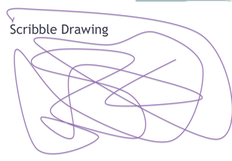scribble it. explore it. color it.

We all do it. We do this when we’re sitting down bored, on the phone, or thinking about what to create next. Yep, I’m talking about the often times ignored and thrown away....scribble! Let’s explore the scribble and give it a little more credence.....
This activity can be done virtually or in person. If done virtually: Follow all directions below and use these modifiers: (a) ask that the person doing the scribble to point their camera to the paper so you can watch the scribble happen. (b) when finished with the activity as described below, ask that the image then be held up to the camera so you an take a screen shot to share, (c) process by sharing a screen shot of the image on the screen.
This activity can be done virtually or in person. If done virtually: Follow all directions below and use these modifiers: (a) ask that the person doing the scribble to point their camera to the paper so you can watch the scribble happen. (b) when finished with the activity as described below, ask that the image then be held up to the camera so you an take a screen shot to share, (c) process by sharing a screen shot of the image on the screen.
We all Need a Starting Point
The scribble can be a starting point for a drawing. The scribble drawing elicits creative self-expression through its spontaneity and helps to decrease the anxiety of drawing due to it’s non-structured nature. We named our company, My Scribble It, as everyone needs a starting point. The journey beyond that starting point is then up to us. Please read below for the instructions on how to create and process the scribble drawing.
The scribble drawing was created by art educator, Florence Cane, and then further developed into a therapeutic art intervention by her sister, Margaret Naumburg. Here is a link to her book, Dynamically Oriented Art Therapy. Their work became the foundation in which the practice of art therapy was built. Keep scrolling to learn how to do The Scribble Drawing.
The scribble drawing was created by art educator, Florence Cane, and then further developed into a therapeutic art intervention by her sister, Margaret Naumburg. Here is a link to her book, Dynamically Oriented Art Therapy. Their work became the foundation in which the practice of art therapy was built. Keep scrolling to learn how to do The Scribble Drawing.
How to Start The Scribble Drawing
To start the scribble drawing it is often times suggested that we stand up and make spontaneous rhythmic moments with our arms, thereby releasing emotion and preparing to then transfer that onto the paper. The creator chooses a color (crayon, marker, colored pencil) that feels right and then holds this above a piece of paper. When comfortable, the instrument is put onto the paper and the drawing begins. Putting the instrument to the paper can be described as a leaf dropping or a feather drifting (Steinhardt, 1989). The scribble is a continuous line of movement until the scribble comes to a rest and the creator puts down the material.
How to Process The Scribble Drawing
The page can be turned in all directions and looked at until an area pops out to be developed. The creator further develops that area of interest chosen and then processes the drawing by talking about it or writing a story. When processing the scribble, the creator can make interpretations and assign personal symbols to the images. The processing part can be very insightful and may just answer a question you might have had when starting this activity! A title is given to the drawing when done.
Several variations of the scribble drawing that have emerged throughout the years.
To learn more (Link):
Steinhardt, L. (1989). Six starting points in art therapy with children. Advances in art therapy. Wadeson, H., Durkin, J., & Perach, D. (Eds.). John Wiley & Sons. p. 336-356.
Several variations of the scribble drawing that have emerged throughout the years.
To learn more (Link):
Steinhardt, L. (1989). Six starting points in art therapy with children. Advances in art therapy. Wadeson, H., Durkin, J., & Perach, D. (Eds.). John Wiley & Sons. p. 336-356.


